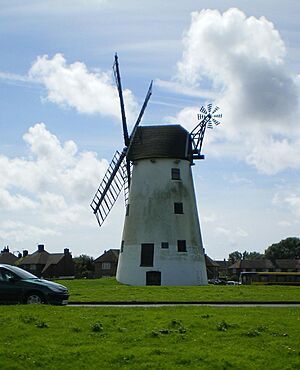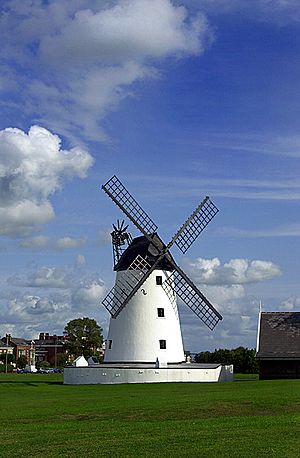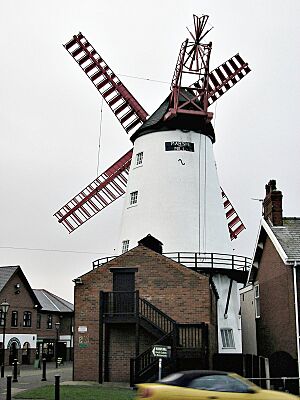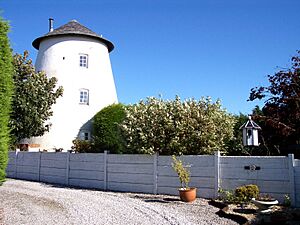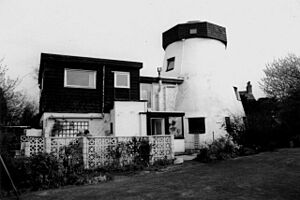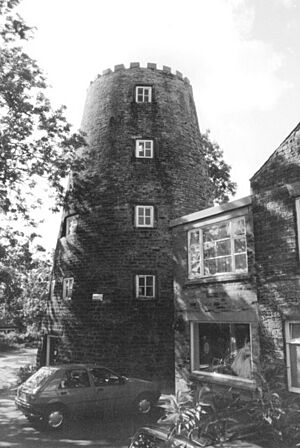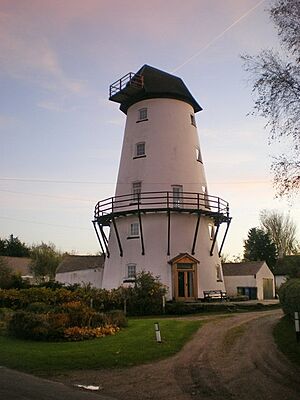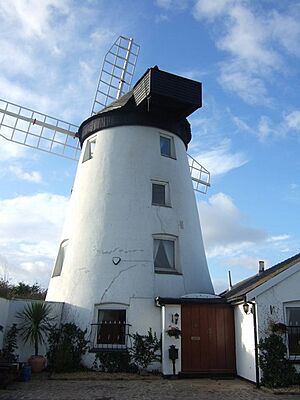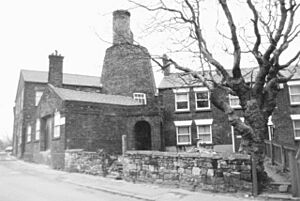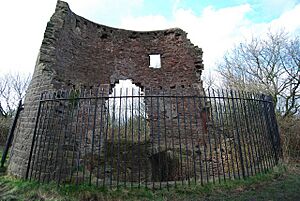List of windmills in Lancashire facts for kids
Lancashire, a historic county in England, is known for its beautiful landscapes and rich history. Part of this history includes many windmills! These amazing structures used the power of the wind to grind grain into flour, pump water, or even saw wood.
Long ago, windmills were super important for daily life. They helped communities get the food they needed. While many have disappeared over time, some still stand today, reminding us of the past. This article will explore some of the windmills found in Lancashire, including areas that are now part of Greater Manchester and Merseyside.
Contents
- What is a Windmill?
- Types of Windmills You Might See
- Famous Windmills in Lancashire
- Little Marton Mill: A Blackpool Landmark
- Lytham Windmill: By the Seaside
- Marsh Mill: A Tall Beauty
- Bickerstaffe Mill: An Old Survivor
- Lydiate Windmill: Forest's Mill
- Parbold Mill: A Hilltop View
- Damside Windmill: A Pilling Landmark
- Staining Mill: A Countryside Mill
- Ravenhead Mill: St Helens History
- Holland Mill: Upholland's Mill
- Harrock Hill Mill: A Ruined Beauty
- Windmills Across the Region
- Why Did Windmills Disappear?
- Images for kids
What is a Windmill?
A windmill is a machine that turns wind power into useful energy. It has large blades, called sails, that catch the wind. These sails then turn a shaft, which powers machinery inside the mill. Most windmills were used to grind grain, but some had other jobs too!
Types of Windmills You Might See
There are a few main types of windmills, each built a bit differently:
- Post Mill: This is one of the oldest types. The entire body of the mill, including the machinery and sails, can turn on a central post. This allows the miller to point the sails into the wind from any direction.
- Tower Mill: These mills have a tall, fixed tower, usually made of brick or stone. Only the cap (the top part with the sails) turns to face the wind. This design made them stronger and able to hold more machinery.
- Smock Mill: Similar to a tower mill, but the tower is made of wood and shaped like a traditional smock (a type of shirt). They often have a wider base and taper upwards.
Famous Windmills in Lancashire
Lancashire has been home to many windmills over the centuries. Here are a few notable ones that you might still hear about or even see today:
Little Marton Mill: A Blackpool Landmark
Located in Little Marton, near the famous town of Blackpool, this tower mill was built in 1838. It's one of the most well-known windmills in the area and is a great example of how these structures looked. It stands tall and proud, reminding everyone of its long history.
Lytham Windmill: By the Seaside
The beautiful Lytham Mill is a tower mill built in 1803. You can find it in Lytham St Annes, right by the seaside. It's a popular spot for visitors and a lovely reminder of the past. Imagine the wind blowing off the sea, turning its sails!
Marsh Mill: A Tall Beauty
In Thornton Cleveleys, you'll find Marsh Mill, another impressive tower mill. It was built in 1794 and is one of the tallest tower mills in Europe! It's a fantastic example of engineering from that time and is still a very important landmark.
Bickerstaffe Mill: An Old Survivor
The Bickerstaffe Mill is a tower mill that has been around since 1756. It's located in Bickerstaffe and is one of the older mills mentioned in records. It shows just how long these structures could last.
Lydiate Windmill: Forest's Mill
Forest's Mill in Lydiate is a tower mill that dates back to 1768. It's another great example of the many windmills that once dotted the landscape of Lancashire and Merseyside.
Parbold Mill: A Hilltop View
Built in 1810, Parbold Mill is a tower mill located in Parbold. Its position on a hill would have given it excellent access to the wind, making it very efficient for grinding grain.
Damside Windmill: A Pilling Landmark
The Damside Windmill in Pilling is a tower mill that was built in 1808. It's a significant historical building in its area, showing the importance of windmills to local communities.
Staining Mill: A Countryside Mill
The Staining Mill in Staining is a tower mill that was built in the late 18th century. It's another example of how these mills were spread throughout the countryside to serve different villages.
Ravenhead Mill: St Helens History
In St Helens, you can find the Ravenhead Mill, a tower mill from the late 18th century. It played a part in the industrial history of the area.
Holland Mill: Upholland's Mill
The Holland Mill in Upholland is a tower mill that was built in 1768. It's another important historical structure that shows the widespread use of windmills in the region.
Harrock Hill Mill: A Ruined Beauty
The Harrock Hill Mill in Wrightington is a tower mill. While it might be ruined now, its remains still tell a story of its past importance and the role it played in the local community.
Windmills Across the Region
Many other places in Lancashire, Greater Manchester, and Merseyside also had windmills. Some were very old, mentioned in records from the 1300s or 1400s! For example, there were mills in Ainsdale, Aughton, Barton-upon-Irwell, Billinge, Birkdale, Boothstown, Bretherton, Burscough, Carleton, Clifton, Culcheth, Freckleton, Golborne, Great Crosby, Haigh, Hambleton, Ince, Kirkham, Liverpool (with many different mills like Wavertree Mill and Gallows Mill), Longton, Maghull, Manchester, Much Hoole, Ormskirk, Preesall, Prescot, Preston, Rimington, Rufford, Salford, Singleton, Southport, Tarleton, Toxteth, Treales, Warton, West Derby, Wrea Green, and Weeton.
These mills came in different types, including post mills, tower mills, smock mills, and even special "wind engines" like those in Southport. Some were destroyed by fires, others were simply taken down as new technologies emerged.
Why Did Windmills Disappear?
As the 1800s turned into the 1900s, new inventions like steam engines and then electric motors became popular. These new machines were often more reliable and could work even when there was no wind. Because of this, many windmills were no longer needed and fell into disuse or were demolished.
Today, the remaining windmills are often protected as historical buildings. They stand as monuments to a time when wind was a primary source of power, and they teach us about the clever ways people used natural resources.
Images for kids


